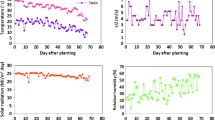Abstract
Corn (Zea mays L.) was grown under full and deficit irrigation in two research field locations near Bushland, TX, in 2018 to compare seasonal water use of two irrigation management approaches. Full irrigation was achieved in both fields by allowing no more than 55% depletion of plant available soil water. However, irrigation depth and frequency were different in each field. The USDA-ARS Conservation and Production Research Laboratory (CPRL) weighing lysimeter fields were generally irrigated twice weekly using irrigation depths ranging from 19 to 32 mm. The Texas A&M AgriLife Research Emeny field was irrigated only once per week, having greater application depths ranging from 35 to 42 mm. Deficit irrigation treatments of 75% of full irrigation were also performed in both research fields. Yield and crop water productivity values for the 100 and 75% lysimeter field irrigation treatments were greater than corresponding values for the Emeny field. Emeny field yields may have been slightly reduced by heat stress incurred between irrigations during early grain fill whereas more frequent irrigations on the lysimeter fields may have reduced heat stress during that period. Results from this study suggest that evaporative losses associated with the more frequent, smaller application depth irrigations on the lysimeter fields did not contribute to appreciably lower CWP values, as losses were likely mitigated by the rapid development of the corn canopy. These findings suggest that corn yield is principally dependent upon seasonal water inputs and losses from frequent, smaller depth irrigations are minimal outside of incomplete canopy conditions.




Similar content being viewed by others
References
Chen Y, Marek G, Marek T, Moorhead J, Heflin K, Brauer D, Gowda P, Srinivasan R (2018) Assessment of alternative agricultural land use options for extending the availability of the Ogallala Aquifer in the Northern High Plains of Texas. Hydrology 5(4):53
Eck HV (1986) Effects of water deficits on yield, yield components, and water use efficiency of irrigated corn 1. Agron J 78(6):1035–1040
Evett SR, Howell TA, Schneider AD, Upchurch DR, Wanjura DF (1996) Canopy temperature based automatic irrigation control. pp. 207-213. In C. R. Camp, E.J. Sadler, and R. E. Yoder (eds.) Proc. International Conference. Evapotranspiration and Irrigation Scheduling, San Antonio, TX
Evett SR, Tolk JA, Howell TA (2003) A depth control stand for improved accuracy with the neutron probe. Vadose Zone J 2(4):642–649
Evett SR, Brauer DK, Colaizzi PD, Tolk JA, Marek GW, O’Shaughnessy SA (2019) Corn and sorghum ET, E, yield and CWP affected by irrigation application method: SDI versus mid-elevation spray irrigation. https://doi.org/10.13031/trans.13314. Accepted by Trans. ASABE, 25 April 2019
Hao B, Xue Q, Marek TH, Jessup KE, Becker J, Hou X, Xu W, Bynum ED, Bean BW, Colaizzi PD, Howell TA (2015) Water use and grain yield in drought-tolerant corn in the Texas High Plains. Agron J 107(5):1922–1930
Hao B, Xue Q, Marek TH, Jessup KE, Hou X, Xu W, Bynum ED, Bean BW (2016) Radiation-use efficiency, biomass production, and grain yield in two maize hybrids differing in drought tolerance. J Agron Crop Sci 202(4):269–280
Hernandez JE, Gowda PH, Howell TA, Marek TH, Ha W (2013) Impact of existing agricultural management practices on groundwater levels in the Texas High Plains. Texas Water J 4(1):22–34
Howell TA, Yazar A, Schneider AD, Dusek DA, Copeland KS (1995) Yield and water use efficiency of corn in response to LEPA irrigation. Transactions of the ASAE 38(6):1737–1747
Kohler MA, Nordenson TJ, Baker DR (1959) Evaporation maps for the United States: US Department of Commerce. Weather Bureau Technical Paper 37:13
Scanlon BR, Reedy RC, Gates JB, Gowda PH (2010) Impact of agroecosystems on groundwater resources in the Central High Plains, USA. Agric Ecosyst Environ 139(4):700–713
Tolk JA, Evett SR, Schwartz RC (2015) Field-measured, hourly soil water evaporation stages in relation to reference evapotranspiration rate and soil to air temperature ratio. Vadose Zone J 14. https://doi.org/10.2136/vzj2014.07.0079
Viets FG (1962) Fertilizers and the efficient use of water. In Advances in Agronomy (Vol. 14, pp. 223-264). Academic Press
Acknowledgments
This research was supported in part by the Ogallala Aquifer Program, a consortium between USDA-Agricultural Research Service, Kansas State University, Texas A&M AgriLife Research, Texas A&M AgriLife Extension Service, Texas Tech University, and West Texas A&M University.
Author information
Authors and Affiliations
Corresponding author
Ethics declarations
Disclaimer
Mention of trade names or commercial products in this publication is solely for the purpose of providing specific information and does not imply recommendation or endorsement by the U.S. Department of Agriculture. The U.S. Department of Agriculture (USDA) prohibits discrimination in all its programs and activities on the basis of race, color, national origin, age, disability, and where applicable, sex, marital status, familial status, parental status, religion, sexual orientation, genetic information, political beliefs, reprisal, or because all or part of an individual’s income is derived from any public assistance program (not all prohibited bases apply to all programs). Persons with disabilities who require alternative means for communication of program information (Braille, large print, audiotape, etc.) should contact USDA’s TARGET Center at 202-720-2600 (voice and TDD). To file a complaint of discrimination, write to USDA, Director, Office of Civil Rights, 1400 Independence Avenue, SW, Washington, DC 20250-9410, or call 800-795-3272 (voice) or 202- 720-6382 (TDD). USDA is an equal opportunity provider and employer.
Conflict of Interest
The authors declare that there is no conflict of interest.
Additional information
Publisher’s Note
Springer Nature remains neutral with regard to jurisdictional claims in published maps and institutional affiliations.
Rights and permissions
About this article
Cite this article
Marek, G.W., Marek, T.H., Evett, S.R. et al. Irrigation Management Effects on Crop Water Productivity for Maize Production in the Texas High Plains. Water Conserv Sci Eng 6, 37–43 (2021). https://doi.org/10.1007/s41101-020-00100-x
Received:
Revised:
Accepted:
Published:
Issue Date:
DOI: https://doi.org/10.1007/s41101-020-00100-x




